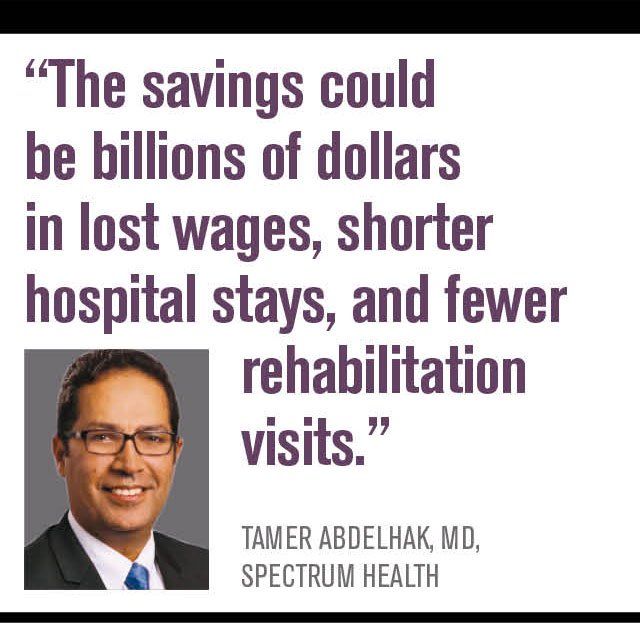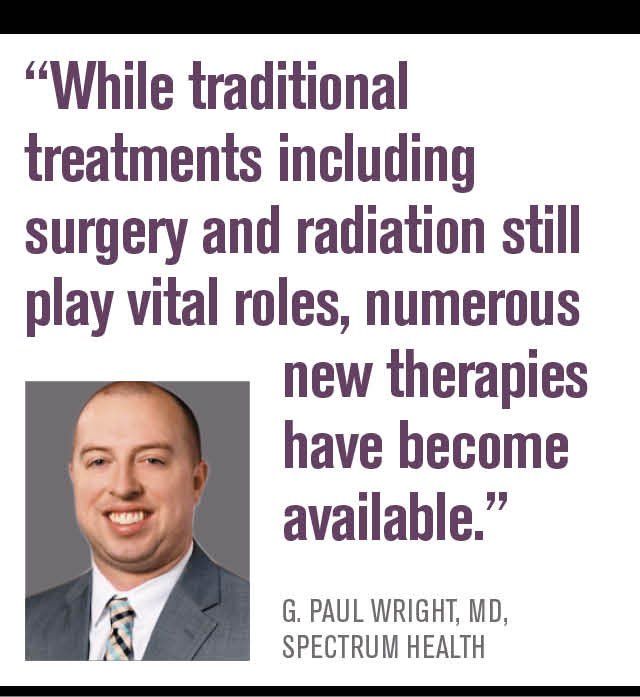Top Four Causes of Female Mortality and Treatment Advances
The conditions that are the biggest drivers of female mortality, some preventive measures, and the latest treatment advances.
Leading Causes of Death

TAMER ABDELHAK, MD

G. PAUL WRIGHT, MD

The leading causes of death in women are heart disease (22.3%), cancer (21.6%), chronic lower respiratory diseases (6.0%), and stroke (6.0%), according to the latest data, based on the year 2014, from the CDC. Despite these staggering statistics, however, new treatments continue to be developed-many of which will help lives and money. Here’s a closer look at the most common conditions within each cause of death category, measures being taken to prevent deaths associated with them, and the latest treatment advances.
HEART DISEASE AND STROKE
Cardiovascular disease, which refers to conditions that involve narrowed or blocked blood vessels that can lead to a heart attack or stroke-such as atherosclerosis and coronary artery disease-is the number one cause of heart disease and death in women. In 2013, nearly 300,000 women died of heart disease-which accounts for about one in every four female deaths, the CDC reports.
Risk factors
Having high blood pressure is a major controllable risk factor for heart disease in women, and is the leading risk factor for heart failure and other heart-related conditions such as heart attack, stroke, and atrial fibrillation, says Carl J. Pepine, MD, cochair of the Cardiovascular Disease in Women Council, American College of Cardiology, and professor and emeritus chief, Division of Cardiovascular Medicine, Shands Hospital at the University of Florida, an academic health center in Gainesville, FL. Other major modifiable risk factors for heart attack include smoking, being overweight or obese, having high blood sugar or diabetes, lack of physical activity, and high cholesterol.
In addition to hypertension, heart disease and high cholesterol are risk factors for stroke, and women have more risk factors for stroke than men, says Tamer Abdelhak, MD, division chief, Inpatient Neurology, Vascular Neurology, and NeuroCritical Care, Clinical Neurosciences Department, Spectrum Health, a not-for-profit integrated health system in Grand Rapids, MI. These risks include:
- Taking birth control pills;
- Natural bodily changes occurring as a result of pregnancy such as increased blood pressure and stress on the heart;
- Using hormone replacement therapy to relieve menopausal symptoms; and
- Suffering from migraine headaches with aura.
Women in hypercoagulable states, such as having more than one miscarriage or deep venous thrombosis, are also at risk for stroke, Pepine says. Smoking, inactivity, and being overweight or obese are risk factors as well.
Prevention
Although approximately 100 medications for high blood pressure exist, better management is needed to help prevent heart disease and stroke, says Pepine. For example, almost half of women in the United States have blood pressure in the hypertensive range, according to new guidelines from the American College of Cardiology and American Heart Association. Many women who should be taking medication for high blood pressure are not.
To reduce death due to heart attack, protocols are now in place to ensure that when paramedics reach a patient suspected of having a heart attack, they can assess the patient right away. If the person is indeed having a heart attack, paramedics will alert the emergency department so they are ready to get the patient to the catheterization lab where they can restore blood flow and aspirate the clot when they arrive. This minimizes the time it takes for the patient to have blood flow returned to heart muscle tissue-reducing the heart attack’s severity, says Thomas F. Boyden, MD, program director, Preventive Cardiology, and medical director, Preventive Cardiology and Cardiac Rehabilitation, Spectrum Health, Cardiovascular Services. Medical breakthroughs have shown that certain medications, such as beta blockers, reduce the chance of having another heart attack or having to return to the hospital due to complications of a heart attack.
Women who need hormonal therapy to aid in contraception or with menopausal symptoms may be able to decrease the risk of blood clots by using hormone medications available in lower doses that are more synthetic-which may cause less blood clotting, Pepine says. However, even low-estrogen birth control pills, in the presence of other risk factors, are associated with increased risk for stroke.
Noteworthy developments
Some breakthroughs have occurred in reducing the incidence of heart attack and stroke in patients at risk of cardiovascular events. A new class of drugs introduced in 2015, PCSK9 inhibitors, uses monoclonal antibodies designed to protect LDL-cholesterol receptors and help reduce LDL-cholesterol, Boyden says. These medications have resulted in a reduced incidence of heart attack even if someone is also taking a statin medication such as Lipitor (atorvastatin) and Crestor (rosuvastatin)-the gold standard therapy for reducing cholesterol and risk of heart attack and stroke.
Like heart attack, timing is critical for getting to the hospital when stroke is suspected. Almost nine out of 10 strokes are due to blood clots, which can be dissolved with special medication and/or removed by special catheter devices. Another newer management approach for stroke within the last two years includes equipping ambulances with computed tomography scan machines, so medical personnel can obtain a brain scan and transmit images to a radiologist, confirm a diagnosis, and start treatment as soon as a patient reaches the emergency room or perhaps even while the patient is still in the ambulance, Pepine says.
Based on recent clinical trials, the window for performing a thrombectomy (removing blood clots) is now (as of January 2018) up to 24 hours. That means that stroke may be a reversible, curable disease if urgent treatments are employed early on, Abdelhak says. A limited number of hospitals in the United States, including Spectrum Health, offer catheter-based stroke care.
Cost implications
Most medications that are approved to treat high blood pressure are offered in generic forms, Pepine says. Many can be taken for just pennies a day. But many women who should be taking medication are not prescribed them, and many who have prescriptions are not taking them-which increases healthcare costs.
PCSK9 inhibitor medications can cost as much as $14,000 annually per patient. With the high cost of these agents and the modest added risk reduction provided by background statin therapy, many healthcare industry analysts have suggested that the cost benefit does not warrant its widespread use, Boyden says. However, if used for the right patients-those at the highest risk of recurrent heart attack, stroke, or death due to cardiovascular disease-others say the annual cost is justified by the reduced risk. These medication costs typically decline over time as manufacturers reassess the market and renegotiate contracts with insurers, so the cost/benefit ratio should improve.
Next: Breast and lung cancer
BREAST AND LUNG CANCER
The two most common types of cancer in women are breast and lung cancer with an estimated 252,170 and 105,510 new cases diagnosed in 2017, respectively, according to the National Cancer Institute’s Surveillance, Epidemiology, and End Results Program. Despite breast cancer accounting for significantly more new diagnoses, lung cancer remains the leading cause of cancer death in women.
Noteworthy developments
Treatment of non-small cell lung cancer has led the way into the era of personalized medicine. “While traditional treatments including surgery and radiation still play vital roles, numerous new therapies have become available,” says G. Paul Wright, MD, surgical oncologist, Spectrum Health. “A patient’s tumor can be tested for molecular alterations that can predict how they will respond to certain medications and provide options for medications that target those specific alterations. This has provided greater precision in the treatments delivered, particularly for those with late-stage or recurrent cancer. Immunotherapies are also available for select patients. These provide effective treatment by sensitizing the cancer cells in a way that allows the patient’s own immune system to combat the disease.”
In breast cancer, recent trends have demonstrated benefits in changing the timing of chemotherapy delivery. “For patients in which chemotherapy is required, more often the chemotherapy is now given prior to surgery when possible,” Wright says. “This allows the treating physician to evaluate the treatment’s effectiveness by examining the specimen at the time of surgery.” Patients that don’t have any remaining tumor have a very good prognosis. Women who have residual tumor after chemotherapy are at high risk for recurrence. Several ongoing trials, such as the CREATE-X trial published in the New England Journal of Medicine, are investigating giving additional medications to women in the latter group to reduce recurrence and improve survival. This has already been shown to be an effective strategy. Immunotherapy has also provided some initial promise in women with certain types of breast cancer.
Angela J. Keleher, MD, director, Division of Breast Surgery, Allegheny Health Network, an academic medical center in Pittsburgh, says great strides are being made in tailoring breast cancer treatments to a woman’s specific tumor profile and developing liquid biopsies that can detect circulating tumor cells and guide physicians in treatment selection. New advances such as breast microseed, a one-time post-lumpectomy treatment, and Gamma Pod, which promises to eradicate breast tumors with just a week of radiation treatments, are shortening treatments for early-stage cancers, contributing to increased quality of life for cancer survivors.
Cost implications
Testing for molecular alterations has steeply decreased in cost over the past decade, however, many new medical treatments are expensive. One year of treatment with a newer immunotherapy drug can exceed $250,000. “While competition in this market is increasing, this has yet to drive down the cost of these therapies,” Wright says. “High costs are likely to limit the sustainability of these approaches and may increase the disparities in access to these treatments.”
Prevention
To save money, Keleher says managed care organizations should emphasize prevention strategies-such as don’t smoke, maintain a proper body weight, exercise regularly, eat a balanced diet with lots of fruits and vegetables, and don’t drink alcohol excessively.
“Healthcare providers should discuss prevention with their patients at high risk for breast cancer,” Keleher says. Preventive measures include changing daily lifestyle behaviors, taking risk reduction medication, or having risk reducing surgery. For gene mutation carriers with a high risk of breast cancer, a prophylactic double mastectomy could save lives and healthcare costs in the long run.
CHRONIC LOWER RESPIRATORY DISEASES
Chronic obstructive pulmonary disease (COPD) is the top killer of women in the category of chronic lower respiratory diseases, with more than 7 million U.S. women having the diagnosis, according to the American Lung Association. This incurable, progressive lung condition that slowly destroys lung function is primarily caused by smoking, says Kiran Nair, DO, pulmonologist, Medical Chest Associates, a practice affiliated with Memorial Hermann Memorial City Medical Center in Houston, Texas. The number of deaths from COPD in women increased four-fold during the 1980s and 1990s.
Treatments
Traditional treatments for COPD include inhaled medications that help keep airways open, such as inhaled bronchodilators and inhaled bronchodilator/corticosteroid combination therapies, says MeiLan Han, MD, associate professor of pulmonary medicine, University of Michigan, Ann Arbor, and spokesperson for the American Lung Association.
Over the past decade, new research has shed light on the underlying complex genetic underpinnings of the disease, and inflammation that drives it, Nair says. Based on this research, new medications in the pipeline target specific cells and components of the inflammation that drives the disease, and genetic markers are being identified that would increase a person’s susceptibility to the disease.
Cost implications
The annual cost of COPD is more than $30 billion, according to CDC estimates. “Any medication that will significantly reduce the frequency of hospitalizations will have a positive impact on the healthcare costs associated with COPD,” Nair says. “Most current medications that are prescribed have been shown to reduce the frequency and severity of hospitalizations, and newly developed medications are being investigated with these goals in mind.”
But affording medications is problematic for many patients, due to multiple factors. Not only have no generic options been available in the United States until this year, Han says, many COPD patients have other conditions for which they must also pay for medications. In general, patients with COPD also tend to have lower socioeconomic status than those without COPD, which means that even modest copays may not be affordable for many.
Karen Appold is a medical writer in Lehigh Valley, Pennsylvania.

This week on Tuning Into The C-Suite Briana Contreras spoke with Dr. Scott Hayworth, president and CEO of New York-based CareMount Medical. In this interview, the two discussed the importance of patients staying in contact with their doctors for the sake of reducing public health risks and to discuss ongoing care options with them.
Listen
Eric Levin talks PBMs and how Scripta is Tackling the Market's Challenges for Patients
July 22nd 2020MHE's Briana Contreras spoke with CEO of Scripta, Eric Levin. The two discussed the current state of the pharmacy benefit market and how the Scripta organization has been assisting its clients and their prescriptions prior to the COVID-19 pandemic and during.
Listen